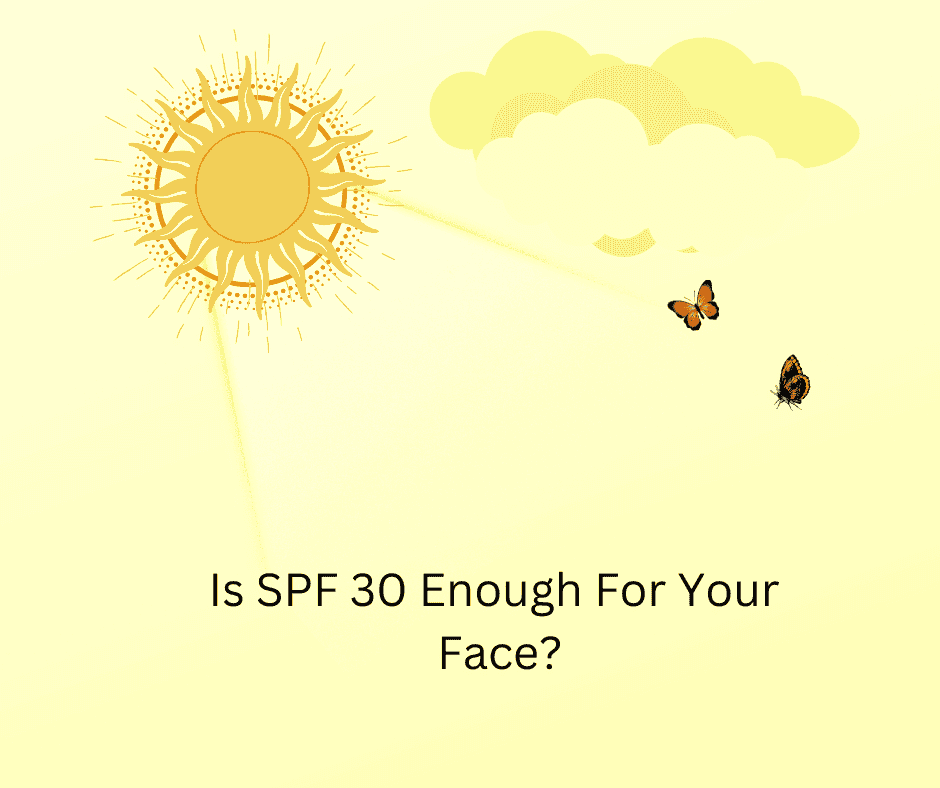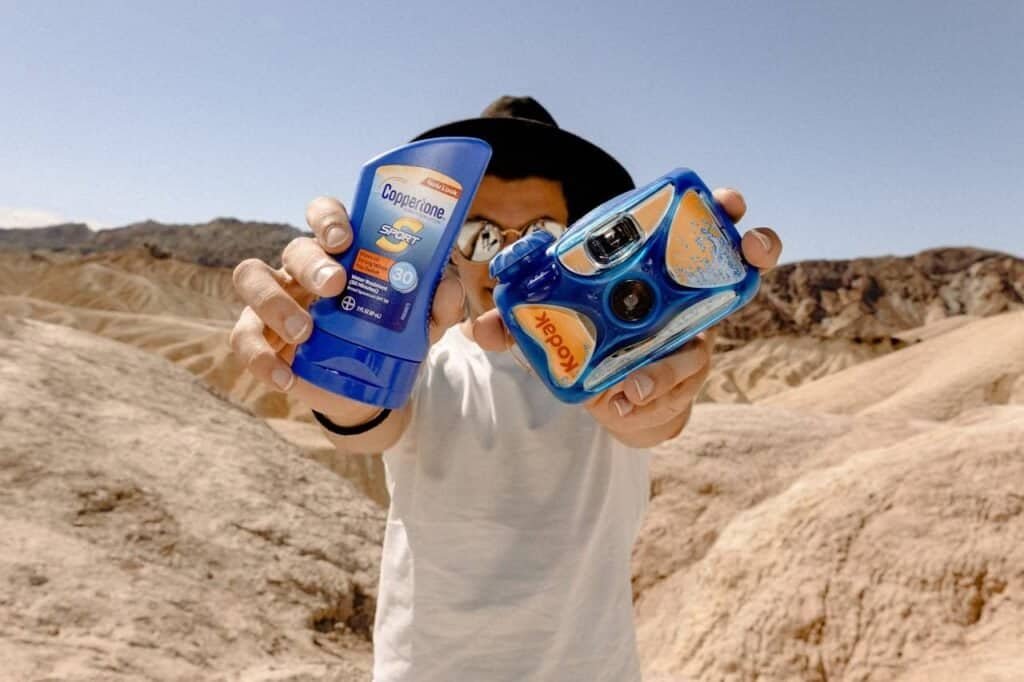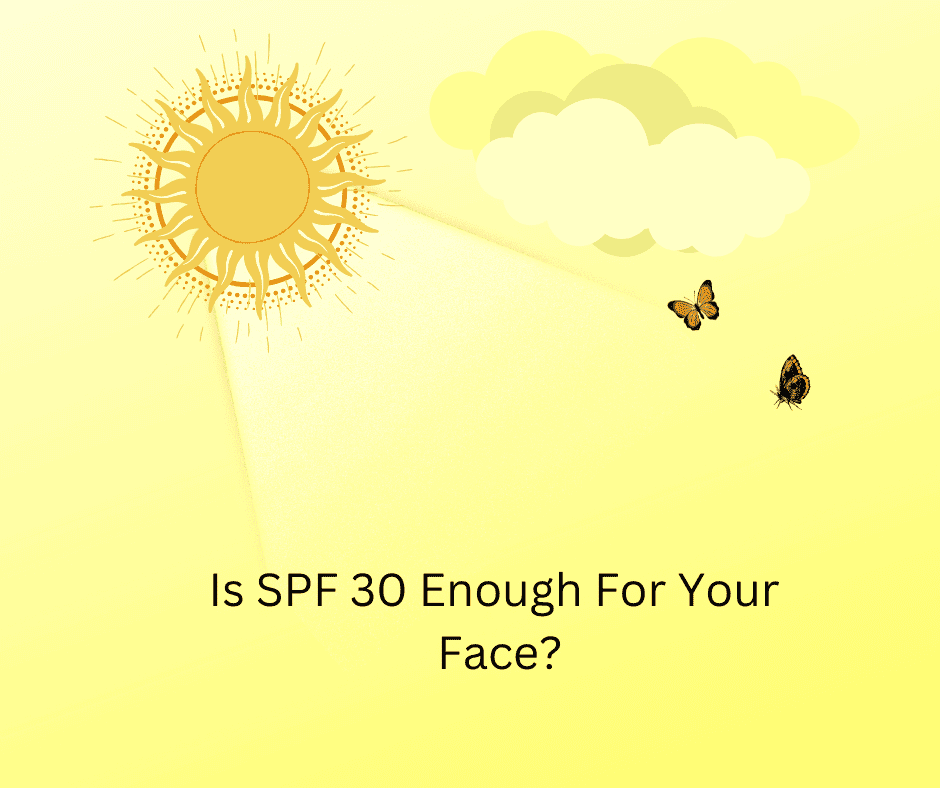
A Sunscreen Protection Guide: Is SPF 30 Enough For Your Face
Contents
Sun slathering with SPF 30 – is it enough to shield your precious face from the sun’s wrath? Find Out Here. Sunscreen is very important. SPF levels and understanding their effectiveness can feel like a confusing science experiment. Fear not, sun seekers! This blog post cuts through the confusion. We’ll give you expert knowledge on SPF 30 for facial protection. We’ll reveal the science behind sun protection. You’ll be able to choose the right sunscreen for your needs. So, ditch the sunburn and join us on a journey to unveil the secrets to a sun-safe, radiant face!

Is SPF 30 Enough for Your Face? Don’t Get Burned by This Answer!
Sunscreen: Your sidekick and the first line of defence against the sun’s harmful rays. But with a plethora of SPF options available, a crucial question arises: is SPF 30 enough for your face?
The answer, like most things in life, is it depends. Here’s the science-backed breakdown to help you navigate the world of sun protection:
Understanding SPF: Decoding the Sun Protection Factor
SPF (Sun Protection Factor) refers to a sunscreen’s ability to block UVB rays. This is the primary culprit behind sunburns. Here’s the math:
● SPF 15: Blocks roughly 93% of UVB rays
● SPF 30: Blocks about 97% of UVB rays
● SPF 50: Blocks around 98% of UVB rays
The difference between SPF 30 and 50 is small (only 1%). This translates to a small reduction in UVB exposure. Yet, it’s important to remember that SPF is just one piece of the sun protection puzzle.

The Case for SPF 30: A Strong Start for Most
The American Academy of Dermatology recommends a broad-spectrum sunscreen. They recommend SPF 30 or higher for daily use. Here’s why SPF 30 is a great starting point for many:
● Blocks a significant amount of UVB rays (97%) . This offers much protection against sunburn, the telltale sign of UVB damage.
● Widely available and affordable. SPF 30 sunscreens are readily available in various formulas and price ranges.
● Effective for everyday activities. For moderate sun exposure during errands or walks, SPF 30 provides adequate protection.
So you slather on SPF 30 every day, thinking you’re good to go. But hold on a second! Here are some reasons why you might go for a higher protection sunscreen:
When SPF 30 Might Not Be Enough
While SPF 30 is a solid choice for many, certain situations call for a higher level of protection:
● Skin conditions matter. People with skin conditions like sensitive skin will benefit more from an SPF 50. Also people with a history of skin cancer should use an SPF 50. Conditions like melasma would also benefit by using SPF 50.
● Activity level: If you’re outdoors for a long time hiking or swimming use SPF 50. Vacationing near the equator wearing SPF 50+ gives better defence from UVA and UVB rays.
● Skin type: Fairer skin tones naturally have less melanin. Melanin is a sun protection pigment. People with fair skin tone need higher SPF for optimal protection.

Remember, reapplication is key! Regardless of SPF, sunscreen breaks down over time due to sweat, swimming, and towel drying. Reapply every two hours, or more frequently if sweating or swimming.
Broad Spectrum Protection: The Missing Piece
Here’s the kicker: SPF guards against UVB rays. It doesn’t fully protect against UVA rays. This leads to sun rays going deeper into the skin and contribute to premature ageing and skin cancer. That’s where “broad-spectrum” comes in. Look for sunscreens labelled “broad spectrum.” This ensures protection against both UVA and UVB rays.
Sun Protection Beyond Sunscreen: A Multi-Layered Approach
Sun protection goes beyond sunscreen. Here are additional ways to shield your face from the sun’s harmful rays:
● Sun-protective clothing: Opt for hats with wide brims and clothing with a UPF rating. UPF is a standard used to measure effectiveness of sun protective fabrics.
● Seek shade: Especially during peak sun hours (10 am – 4 pm), find shade whenever possible.

Finding a sunscreen you love to wear is key to consistent sun protection. Here’s what to look for in a face-friendly sunscreen:
- Lightweight Formula: Lotions, gels, and fluids are more comfortable on the face. These are better than thicker creams. They absorb quickly and won’t leave a greasy residue.
- Non-Comedogenic: Labels the sunscreen as less likely to clog pores and cause breakouts. Ideal for those with oily or acne-prone skin.
- Oil-Free: Opt for oil-free sunscreens to minimize shine and prevent clogged pores.
- Fragrance-Free: Fragrances can irritate sensitive skin. Choose a fragrance-free sunscreen to minimize the risk of irritation.
- Water-resistant: If you sweat or swim, opt for a water-resistant sunscreen. Look for labels indicating water resistance for 40 minutes or 80 minutes.
- Mineral or Chemical? Both mineral and chemical sunscreens offer effective protection. Mineral sunscreens are gentler on sensitive skin. Chemical sunscreens often feel lighter and more sheer.

Additionally, consider your skin type:
● Dry Skin: Look for sunscreens with hydrating ingredients like hyaluronic acid or ceramides.
● Oily Skin: Choose a mattifying sunscreen with a lightweight, oil-free formula.
● Sensitive Skin: Opt for a mineral sunscreen labelled fragrance-free and non-comedogenic.
Remember, patch testing is always recommended! Apply a small amount of sunscreen to your inner forearm. Wait 24 hours to check for any irritation before applying it to your face.
By following these tips you can find a face-friendly sunscreen. This will provide you excellent protection without compromising on comfort or aesthetics.
Conclusion: Safe Sun Practices for a Radiant You
Understand SPF and use broad-spectrum sunscreen. Wear sun-protective clothing. Empower your skin to face the sun with confidence. Keep consistent! Make sun protection a daily habit! Enjoy a lifetime of healthy, glowing skin.
